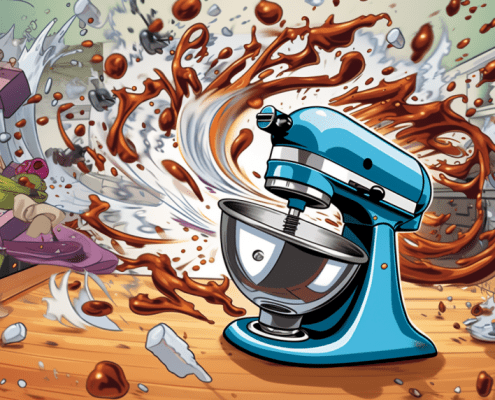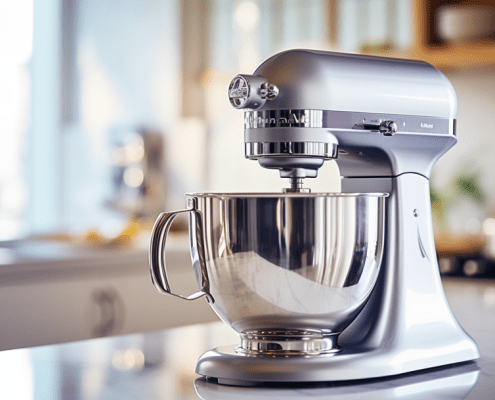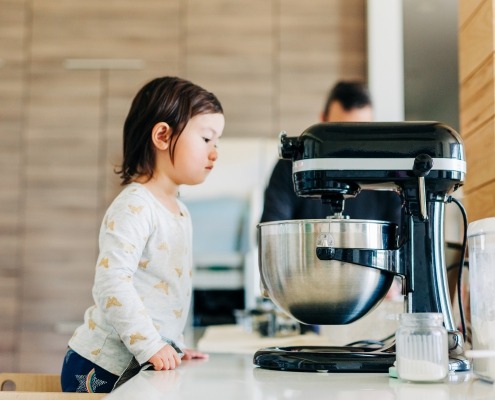How to Keep a KitchenAid Stand Mixer From Moving While Mixing
Steven E / Thursday July 10, 2025
Ever fired up your KitchenAid mixer only to watch it slowly “walk” across the counter? Not only is it annoying, but it can also be dangerous if it tips over. Luckily, keeping your mixer steady is easier than you think. Here are some quick stability tips to stop your KitchenAid stand mixer from moving and keep it safe while you whip up your next snack.
The information in this article may not apply to your specific appliance model. We recommend consulting your manufacturer’s documentation or contact us with any questions.
Why Does a KitchenAid Mixer Walk?
Your mixer’s “walking” happens because of vibration and force, and it’s often a sign of one or more of these issues:
- Unbalanced load: Dough or batter stuck to one side of the bowl can throw off balance.
- Too much resistance: Overloading the mixer with a heavy dough or thick batter can cause it to strain and shake.
- Worn or misaligned feet: The rubber feet on the bottom of your mixer keep it from sliding. If they’re worn or missing, your mixer has nothing to grip.
- Improper surface: Slippery or uneven countertops can make even a perfectly functioning mixer wobble and move.
- Internal loose parts: In rare cases, loose screws or parts inside the mixer can make it vibrate more than normal.
Now let’s break down how you can test and fix each of these problems step by step.
Start With the Basics: Level and Stable Surface
First things first, where you place your mixer matters more than you might think.
- Make sure your countertop is level and stable.
- Avoid placing the mixer on a cutting board, mat, or thin panel that can slide or flex.
- Wipe down the countertop to remove flour, sugar, or grease that could make it slippery.
If your counter itself is uneven, consider adding a small piece of non-slip rubber mat under the mixer for added grip.
Check and Adjust the Rubber Feet
On the underside of your stand mixer, you’ll find four rubber feet. These provide grip and cushion to absorb vibrations. Over time, they can wear down, harden, or even fall off completely.
What to check:
- Turn your mixer on its side and inspect each foot.
- Are they all intact and firmly attached?
- Do they feel soft and grippy, or are they hard, cracked, or missing?
How to fix:
- If a foot is missing or damaged, remove the old pad and clean the surface.
- Order replacement rubber feet specific to your mixer model.
- Attach the new feet securely, making sure they’re level.
A simple set of fresh rubber feet can make a world of difference in keeping your mixer steady.
Balance the Load
Another common cause of walking is an unbalanced load in the bowl. When dough or batter clumps to one side, the beater has to work harder on that side, creating uneven resistance.
Tips for balancing:
- Stop the mixer occasionally to scrape down the sides of the bowl with a spatula.
- Add ingredients gradually so they mix evenly rather than clumping.
- Don’t overload the bowl; follow your mixer’s recommended capacity.
A well-balanced mixture reduces strain on the motor and helps keep the mixer steady.
Don’t Overload Your Mixer
Every KitchenAid mixer has a rated capacity, and pushing beyond that can lead to shaking, overheating, and even damage.
Common capacity limits:
- 4.5–5 quart mixers: up to 8 cups of flour.
- 6-quart mixers: up to 14 cups of flour.
- Always refer to your specific model’s manual for exact numbers.
When kneading bread dough, stick to the recommended amount and use the proper speed (usually speed 2 for heavy dough). Going beyond what your mixer is designed for is one of the biggest causes of vibration and walking.
Adjust the Beater-to-Bowl Clearance
If the beater is set too low, it can scrape the bowl, increasing resistance and causing extra vibration. If it’s too high, it won’t mix properly and can throw off balance.
How to adjust:
- Unplug the mixer.
- Attach the flat beater and lower the head (on tilt-head models) or raise the bowl (on bowl-lift models).
- Insert a flat piece of parchment or a dime into the bowl.
- Turn the adjustment screw slightly until the beater just brushes the paper or dime without pressing hard.
This adjustment improves mixing performance and reduces strain on the motor, keeping your mixer running smoothly and quietly.
Tighten Internal Parts
If you’ve ruled out all the external factors and your mixer still vibrates excessively, it’s time to look inside. Over years of use, screws and brackets inside the housing can loosen slightly.
How to check:
- Unplug the mixer and remove the rear cover by unscrewing the two screws.
- Check that the speed control plate and internal brackets are tight and properly aligned.
- Use a screwdriver to snug any loose screws.
While you’re at it, inspect the worm gear area for excessive wear or missing grease, though this is rarely the direct cause of walking, it’s good maintenance.
Add a Non-Slip Mat
If you’ve done all the mechanical checks and your mixer still shifts a little (especially on particularly smooth counters), adding a non-slip mat is a quick, inexpensive fix.
- Cut a piece of non-slip shelf liner or use a silicone baking mat.
- Place it under the mixer before you start.
- The extra friction will help keep it planted.
Tips for Using Your Mixer Without Walking
Once you’ve addressed the mechanical and surface issues, keep these habits in mind:
- Always start at the lowest speed and gradually increase as needed.
- Don’t leave the mixer running unattended; even a properly functioning mixer can shift slightly if overloaded.
- Stay within your model’s recommended capacity for heavy doughs.
- Periodically check that the rubber feet and internal parts stay tight and in good condition.
Common Questions About Mixer Walking
Is it normal for my mixer to move a little?
A slight vibration is normal, especially when kneading heavy dough. But it shouldn’t be sliding significantly or threatening to fall off the counter.
Can walking damage my mixer?
Yes, if left unchecked, excessive vibration and movement can strain the motor, wear down parts prematurely, and even lead to a fall that damages the housing or motor.
Do larger mixers walk more?
Not necessarily. Larger mixers are heavier and usually more stable, but overloading or worn feet can still cause walking in any model.
Where To Find Us
If you need any replacement parts for your appliances, you can enter your model number at AppliancePartsPros.com to locate and order them quickly. Most orders arrive in just two business days, and we have tons of great information in our repair help section and YouTube videos to help you troubleshoot.
Stay connected with the latest DIY tips, tutorial videos, and repair guides by following us on Facebook, Instagram, and Twitter. We love hearing about your repair stories and successes. If you need more help or want personalized guidance, feel free to reach out. We’re ready to help you take on your next project with confidence!
With nearly a decade of experience in providing top-notch customer service regarding appliance parts and repair, Steven enjoys sharing practical advice, troubleshooting tips, and interesting information to help readers stay informed.





